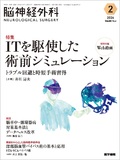Japanese
English
- 有料閲覧
- Abstract 文献概要
- 1ページ目 Look Inside
- 参考文献 Reference
Point
・脳室穿刺は,約100年前から頭部を計測して行われていた.
・術前シミュレーションで手術前に頭部計測の誤差を知り,修正する.
・VPシャント術は,頭頂-後頭アプローチによる後角穿刺を第一選択とする.
・LPシャント術は,第2/3か3/4腰椎間からの傍正中穿刺を第一選択とする.
Ventricular puncture is a basic procedure that neurosurgeons learn in the early stages of their careers and is also performed in ventricular drainage and neuroendoscopic surgery. However, few neurosurgeons are confident in their ability to insert and place a ventricular catheter in the optimal position for ventriculoperitoneal(VP)shunting in a single pass. Even experienced neurosurgical consultants confident in difficult microsurgical procedures are uncomfortable with ventricular catheter placement in VP shunting. Moreover, many neurosurgeons believe that they will never perform a ventricular puncture from the posterior horn of the lateral ventricles. The reason for thinking that ventricular puncture via the anterior horn is safer and more accurate compared with the posterior approach is because the anterior approach can use facial landmarks such as eyes, nose, and ears. However, even with the anterior approach in VP shunting, it is more difficult than with ventricular drainage or neuroendoscopic surgery to achieve accurate placement owing to head rotation, and the success rate has been reported to be as high as 50%.
In this article, I introduced “fool proof,”which uses preoperative simulation to place a ventricular catheter in the optimal position according to the size and shape of each patient's head and ventricles. The first choice for VP shunting is the right parieto-occipital approach with a posterior horn puncture from Frazier's Point and, for L-P shunting, a paramedian puncture from the 2/3 or 3/4 lumbar interspace.

Copyright © 2024, Igaku-Shoin Ltd. All rights reserved.


